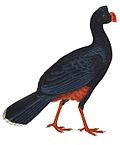Austinornis
Appearance
(Redirected from Austinornis lentus)
| Austinornis Temporal range:
| |
|---|---|
| Scientific classification | |
| Domain: | Eukaryota |
| Kingdom: | Animalia |
| Phylum: | Chordata |
| Clade: | Dinosauria |
| Clade: | Saurischia |
| Clade: | Theropoda |
| Clade: | Avialae |
| Clade: | Ornithuromorpha |
| Clade: | Ornithurae |
| Genus: | †Austinornis Clarke, 2004 |
| Type species | |
| †Austinornis lentus (Clarke, 2004)
| |
| Synonyms | |
|
Ichthyornis lentus (Marsh, 1877) | |
Austinornis is an extinct genus of prehistoric bird of uncertain phylogenetic placement from the Late Cretaceous of Texas. The paleontologist Julia A. Clarke named the genus in 2004 based on a partial tarsometatarsus fossil from Austin Chalk.[1] Although Austinornis was thought to be a pangalliform,[1] other researchers have disputed its classification and dismissed it in phylogenetic analyses due to the fragmentary nature of the holotype.[2][3][4] Notably, in 2014, Gerald Mayr suggested that Austinornis is a non-neornithine from the Coniacian or Santonian age and that the specimen probably belongs to the ornithurine Apatornis or Iaceornis.[5]
References
[edit]- ^ a b Clarke, J.A. (2004). "Morphology, phylogenetic taxonomy, and systematics of Ichthyornis and Apatornis (Avialae: Ornithurae)". Bulletin of the American Museum of Natural History. 286: 1–179. doi:10.1206/0003-0090(2004)286<0001:mptaso>2.0.co;2. hdl:2246/454. S2CID 84035285.
- ^ Cécile Mourer-Chauviré; Martin Pickford; Brigitte Senut (2011). "The first Palaeogene galliform from Africa". Journal of Ornithology. 152 (3): 617–622. doi:10.1007/s10336-010-0630-9. S2CID 1799305.
- ^ Braun, Edward L.; Cracraft, Joel; Houde, Peter (2019). "Resolving the Avian Tree of Life from Top to Bottom: The Promise and Potential Boundaries of the Phylogenomic Era". Avian Genomics in Ecology and Evolution. pp. 151–210. doi:10.1007/978-3-030-16477-5_6. ISBN 978-3-030-16476-8. S2CID 198399272.
- ^ Ksepka, Daniel T.; Early, Catherine M.; Dzikiewicz, Kate; Balanoff, Amy M. (October 2022). "Osteology and neuroanatomy of a phasianid (Aves: Galliformes) from the Miocene of Nebraska". Journal of Paleontology. 97: 223–242. doi:10.1017/jpa.2022.80. ISSN 0022-3360. S2CID 253033983.
- ^ Mayr, Gerald (March 2014). Smith, Andrew (ed.). "The origins of crown group birds: molecules and fossils". Palaeontology. 57 (2): 231–242. Bibcode:2014Palgy..57..231M. doi:10.1111/pala.12103. S2CID 85180754.




